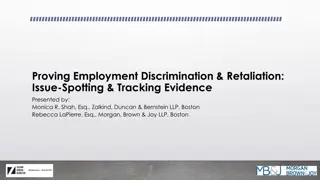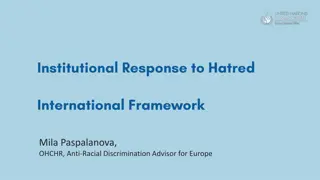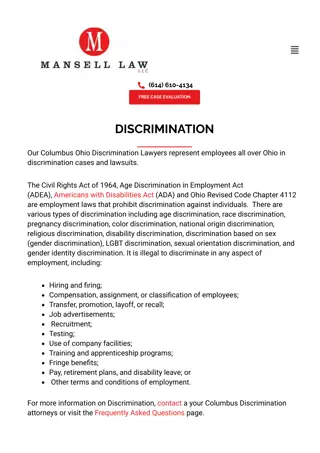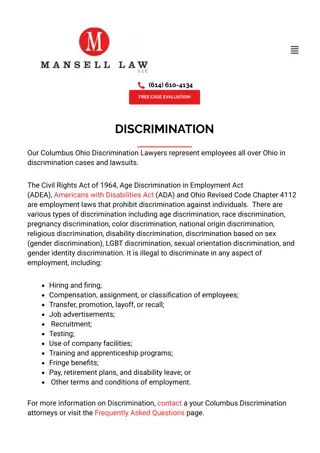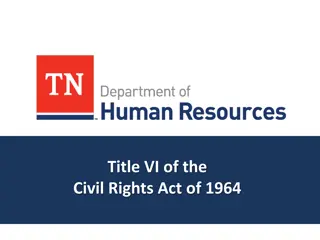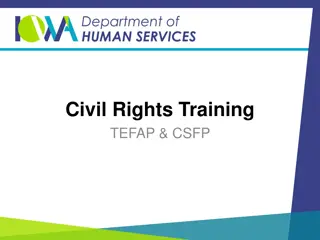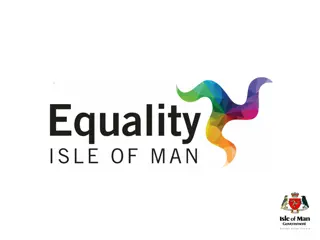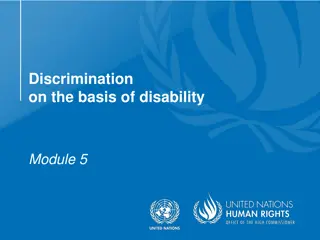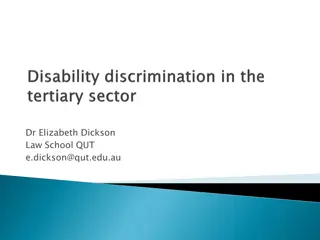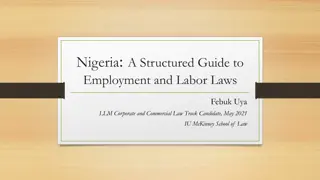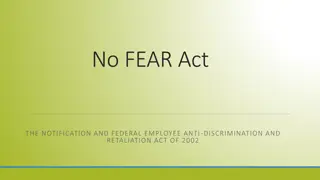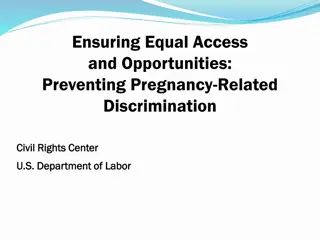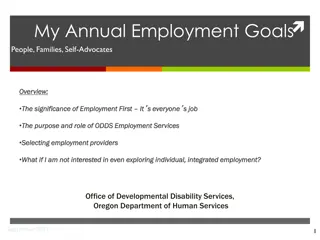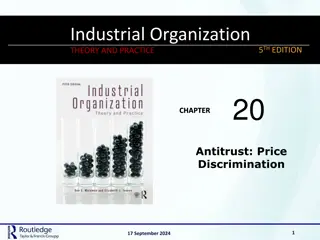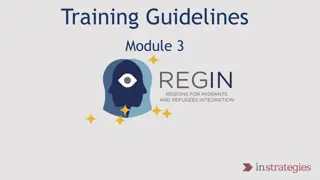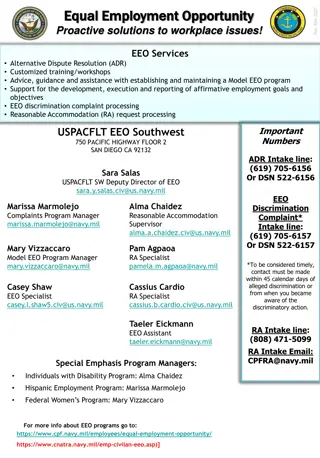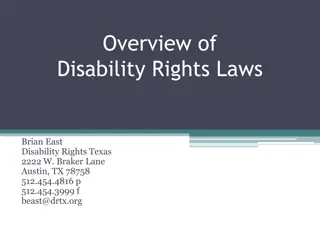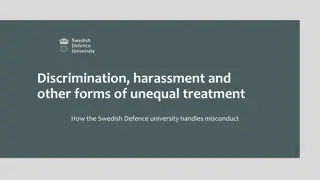Overview of Federal Discrimination Laws in Employment
Federal discrimination laws protect employees from discrimination, harassment, and retaliation in the workplace based on various protected characteristics. Title VII, ADA, ADEA, EPA, Lilly Ledbetter Fair Pay Act, and GINA are key federal laws ensuring fair treatment of employees. These laws cover all aspects of employment such as recruiting, hiring, promotion, compensation, and termination. Employers must adhere to these laws to create a respectful and inclusive work environment.
Download Presentation

Please find below an Image/Link to download the presentation.
The content on the website is provided AS IS for your information and personal use only. It may not be sold, licensed, or shared on other websites without obtaining consent from the author.If you encounter any issues during the download, it is possible that the publisher has removed the file from their server.
You are allowed to download the files provided on this website for personal or commercial use, subject to the condition that they are used lawfully. All files are the property of their respective owners.
The content on the website is provided AS IS for your information and personal use only. It may not be sold, licensed, or shared on other websites without obtaining consent from the author.
E N D
Presentation Transcript
Federal Discrimination Laws
Federal Discrimination Laws WELCOME! 2
Introduction There are numerous federal laws that prohibit employers, including employment agencies and unions, from discriminating in employment based on race, color, religion, sex (including pregnancy, gender identity and expression and sexual orientation), national origin, disability, age or genetic information. These laws also prohibit retaliation against people who complain of discrimination or participate in an equal employment opportunity (EEO) investigation. 3
Agenda Federal discrimination laws. Definition of discrimination. Definition of harassment. Categories of harassment related to protected status. Definition of retaliation. Employer liability for harassment Costs for violations. Our policy and procedures. Responsibilities of supervisors. 4
Federal Discrimination Laws Title VII of the Civil Rights Act, the Americans with Disabilities Act (ADA), the Age Discrimination in Employment Act (ADEA), the Equal Pay Act (EPA), the Lilly Ledbetter Fair Pay Act and the Genetic Information Nondiscrimination Act (GINA) are federal laws that protect employees from discrimination, harassment and retaliation. These laws prohibit employers with at least 15 employees (20 for the ADEA), including employment agencies and unions, from discriminating in employment based on race, color, religion, sex (including gender identity and expression, pregnancy and sexual orientation), national origin, disability, age or genetic information. The EPA covers virtually all employers. They also prohibit retaliation against people who complain of discrimination or participate in an EEO investigation. These federal laws help create a workplace where employees are treated with respect and dignity. 5
Federal Discrimination Laws (cont.) Title VII, the ADA, the ADEA, the EPA, the Lilly Ledbetter Fair Pay Act and GINA prohibit discrimination in all aspects of prehire and the employment relationship including: Recruiting Interviewing Hiring Promotion Demotion Job transfer Compensation Training Discipline Benefits administration Termination/dismissal 6
Definition of Discrimination Discrimination is any policy or action taken related to recruiting, hiring, promotion, pay or training practices that results in an unfair disadvantage to either an individual or group of individuals who are considered part of a protected class. It is illegal to discriminate against a job applicant or an employee because of the person's race, color, religion, sex (including pregnancy, gender identity or expression, and sexual orientation), national origin, age (40 or older), disability or genetic information. 8
Definition of Discrimination (cont.) State laws may further define discrimination to include additional protections, such as: Marital status Domestic partnership. Parenthood. Political affiliation. Criminal or arrest record. Victim of domestic violence, stalking or sexual assault. Matriculation. Personal appearance Smoking or tobacco use. Use of medical marijuana. Receipt of public assistance. 9
Definition of Discrimination (cont.) Discrimination includes: Retaliation against an individual for filing a charge of discrimination, participating in an investigation or opposing discriminatory practices. Employment decisions based on stereotypes or assumptions about the abilities, traits, or performance of individuals of a certain sex (including sexual orientation and gender identity or expression), race, age, religion or ethnic group, or individuals with disabilities. Denying employment opportunities to a person because of marriage to, or association with, an individual of a particular race, religion or national origin or an individual with a disability. Title VII also prohibits discrimination because of participation in schools or places of worship associated with a particular racial, ethnic or religious group. 10
Definition of Discrimination (cont.) The employment action must result in a tangible employment action that is a change in employment status or the privileges of employment, and the basis for doing so must be due to the employee s protected status. Discrimination is: Illegal Costly Disrespectful 11
Group Discussion Are these actions by a supervisor discriminatory? Why or why not? 1. Increases Jane s workload but not Juan s. 2. Assigns Juanita to the graveyard shift because she is always late. 3. Changes Mohamed s job description so he can leave early on Friday. 4. Does not include Rory in the weekly staff meetings because interpreters are too expensive. 5. Reassigns George s work assignments, which limits his opportunities for bonuses, salary increases and promotions. 6. Changes Maria s job title with no change in pay, bonuses, salary or opportunities for advancement. 12
Definition of Harassment According to the EEOC, harassment is a form of employment discrimination that violates Title VII of the Civil Rights Act of 1964, the ADEA and the ADA. Harassment is unwelcome conduct that is based on race, color, religion, sex (including sexual orientation and gender identity and expression), pregnancy, national origin, age (40 or older), disability or genetic information. 14
Definition of Harassment (cont.) Harassment becomes unlawful where: Enduring the offensive conduct becomes a condition of continued employment, or The conduct is severe or pervasive enough to create a work environment that a reasonable person would consider intimidating, hostile or abusive. Anti-discrimination laws also prohibit harassment against individuals in retaliation for filing a discrimination charge, testifying, or participating in any way in an investigation, proceeding, or lawsuit under these laws or for opposing employment practices that they reasonably believe discriminate against individuals, in violation of these laws. 15
Categories of Harassment Related to Protected Status National Origin It is illegal to discriminate based on an employee s birthplace, ancestry, culture or linguistic characteristics common to a specific ethnic group. For example, it would be discriminatory harassment to require employees to speak only English unless an employer shows that the requirement is necessary for conducting business. Disability The ADA prohibits workplace discrimination on the basis of disability. Illegal harassment occurs when a worker with a disability is constantly subjected to pervasive and severe harassment due to his or her disability, resulting in a hostile work environment for the employee. 16
Categories of Harassment Related to Protected Status (cont.) Sex Discrimination It is illegal to discriminate on the basis of sex, gender identity or expression or sexual orientation. Requests for sexual favors in exchange for preferential treatment and workplace conditions that create a hostile environment for persons of either gender constitute sexual harassment. Pregnancy-Based Discrimination Pregnancy, childbirth and related medical conditions must be treated in the same way as other temporary illnesses or conditions and not be used for discriminatory treatment. Harassment for this protected status, for example, would be ridiculing an employee for her appearance during pregnancy. 17
Categories of Harassment Related to Protected Status (cont.) Age Discrimination The ADEA protects individuals who are 40 and older from discrimination. An example of harassment based on age would be repeatedly referring to an older worker as gramps or granny, creating a hostile work environment. Race/Color It is illegal to discriminate on the basis of race or color. Slurs or jokes, offensive or derogatory comments, or other verbal or physical conduct based on an employee s race or color constitutes discriminatory harassment if that conduct creates an intimidating, hostile or offensive work environment and prohibits an employee from performing his or her job. 18
Categories of Harassment Related to Protected Status (cont.) Religion An employer cannot discriminate based on an employee s religious beliefs or practices. Harassment based on religion occurs when an employee is antagonized or ridiculed because of his or her religious, moral or ethical beliefs. Another type of religious harassment occurs when a co-worker or supervisor preaches or proselytizes to an employee and the employee perceives that behavior to be unwanted and offensive, amounting to a hostile work environment. 19
Examples of Harassment Flirting, advances or propositions of a sexual nature. Demeaning remarks, insults, humor or jokes, including statements about an individual s body or clothing, national origin, culture, sex, race, age, religion or disability. Offensive displays, texts or images of sexually suggestive objects or pictures. Offensive touching, such as patting, pinching, hugging or repeated brushing against an individual's body; sexual assault; or suggestions that submission to or rejection of sexual advances will affect decisions regarding an employee s work assignments, status, salary, benefits or other terms or conditions of employment. 20
Definition of Retaliation In the employment context, retaliation occurs when an employer takes an adverse action against a covered individual because the employee engaged in a protected activity. Retaliatory actions include terminating employment, demoting employees or illegal harassment of employees for their filing a charge of discrimination, for participating in a discrimination investigation or proceeding, or for their opposing discrimination. Retaliation is illegal, disrespectful and costly. 22
Group Discussion The following are common employer mistakes that may result in an Equal Employment Opportunity Commission (EEOC) charge. Respond in the form of a question, just like in the popular game show. 1. Employer dress code policy states that due to customer preferences, all men must be clean shaven. 2. Zola s telecommuting request is denied because she participated in a sexual harassment investigation last year. 3. John s promotion is being denied because he has a terminally ill child and has missed a lot of work. 4. Maria is disciplined for not being a team player. She has been overheard speaking Spanish in the break room to her friends and on the telephone to her family. 23
Employer Liability for Harassment According to the EEOC: The employer is automatically liable for harassment by a supervisor that results in a negative employment action such as termination, failure to promote or hire, and loss of wages. If the supervisor's harassment results in a hostile work environment, the employer can avoid liability only if it can prove that: 1) it reasonably tried to prevent and promptly correct the harassing behavior; and 2) the employee unreasonably failed to take advantage of any preventive or corrective opportunities provided by the employer. The employer will be liable for harassment by nonsupervisory employees or non-employees over whom it has control (e.g., independent contractors or customers on the premises), if it knew or should have known about the harassment and failed to take prompt and appropriate corrective action. 25
Costs for Violations Penalties or damages may include prospective pay, back pay, lost benefits and compensation for emotional damage. Victim s attorney fees, expert witness fees and court costs. Actual and hidden costs associated with your organization s reputation in the community. Compensatory and punitive damages may be awarded in cases involving intentional discrimination, ranging from $50,000 to $300,000, depending on the size of the employer. Liquidated damages can be awarded equal to the amount of back pay awarded to the victim in especially malicious or reckless acts of discrimination violations under the Equal Pay Act or ADEA. 26
Costs for Violations (cont.) Your costs as supervisors include: Increased workload and lost productivity = more work for you! Your reputation in the organization if you are the subject of an EEOC charge or lawsuit. Direct or indirect legal costs, which may affect your personal financial stability and/or the organization s profitability. 27
Group Discussion: You Be the Judge Avery filed an EEO grievance with HR six months ago. She has always been hard to supervise. You want someone else to manage her, and you instructed HR to transfer her to another department. HR says the only available position may involve a change in title and pay. Would transferring her be considered discrimination, harassment or retaliation? 28
Group Discussion: You Be the Judge (cont.) Andres constantly complains that his back hurts. You are so tired of hearing his complaints that you told him he cannot work until he provides you with proof that he has seen a doctor and the doctor says he is fit to work. Furthermore, he must provide you with a copy of the diagnosis and any prescriptions. Although Andres complains a lot, there are no significant attendance or performance issues. Are your actions illegal discrimination, harassment or retaliation? 29
Our Policy and Procedures for Discrimination, Harassment and Retaliation 31
Responsibilities of Supervisors Know and comply with our policy and procedures. Immediately report any complaint that you receive from your employees or incidents that you witness involving other supervisors employees to the HR director. When handling harassment complaints from your employees: Respond to employees complaints as soon as possible. Demonstrate your willingness to hear and objectively discuss complaints. 32
Responsibilities of Supervisors Inform the employee that you must report all complaints to HR. Tell the employee that confidentiality will be respected as much as possible but cannot be ensured in order to fully and properly investigate employee concerns/allegations. Do not object if an employee prefers to or actually bypasses the standard chain of command. Do not engage in retaliation against an employee who complains of harassment or discrimination. 33
Responsibilities of Supervisors During investigations conducted by HR or the company s legal counsel: Be available for interviews and provide as much information as possible. Make employees available for interviews. Once an investigation has been completed, if disciplinary action is to be taken, work with HR to make sure that: The victim is not adversely affected. The harassment stops and does not recur. 34
Group Discussion: You Be the Judge An employee hired about one month ago has been involved in confrontations with other employees and has claimed sexual harassment and age discrimination. An internal investigation of his allegations did not support his claims of sexual harassment or discrimination. You think he is a troublemaker and would like to terminate his employment. Furthermore, your company policy says that the first 90 days of employment is a trial period. During the 90-day trial period, an employee can be terminated for any reason at the sole discretion of the company. Is terminating this employee discrimination, harassment, retaliation or a good employment decision that will save the company at lot of money and trouble in the future? Explain your answer. 36
Summary Title VII, the ADA, the ADEA, the Equal Pay Act, the Lilly Ledbetter Fair Pay Act and GINA are federal laws that protect employees from discrimination, harassment and retaliation. Discrimination is any policy or action taken related to recruiting, hiring, promotion, pay or training practices that results in an unfair disadvantage to either an individual or group of individuals who are considered part of a protected class. 38
Summary (cont.) In the employment and legal context, harassment is defined as conduct or actions, based on race, religion, sex (including gender identity and expression, sexual orientation and pregnancy), national origin, age, disability, or genetic information severe or pervasive enough to create a hostile, abusive or intimidating work environment for a reasonable person. 39
Summary (cont.) In the employment context, retaliation occurs when an employer takes an adverse action against a covered individual because the employee engaged in a protected activity. Penalties/damages for violations of federal laws may include prospective or back pay, lost benefits and punitive damages. Supervisors are responsible for knowing and complying with our policy and procedures, immediately reporting any complaints or incidents, and cooperating with investigations and any disciplinary action. 40
Training Evaluation Please complete the training evaluation sheet included in the handouts. Thank you for your interest and attention! 42


